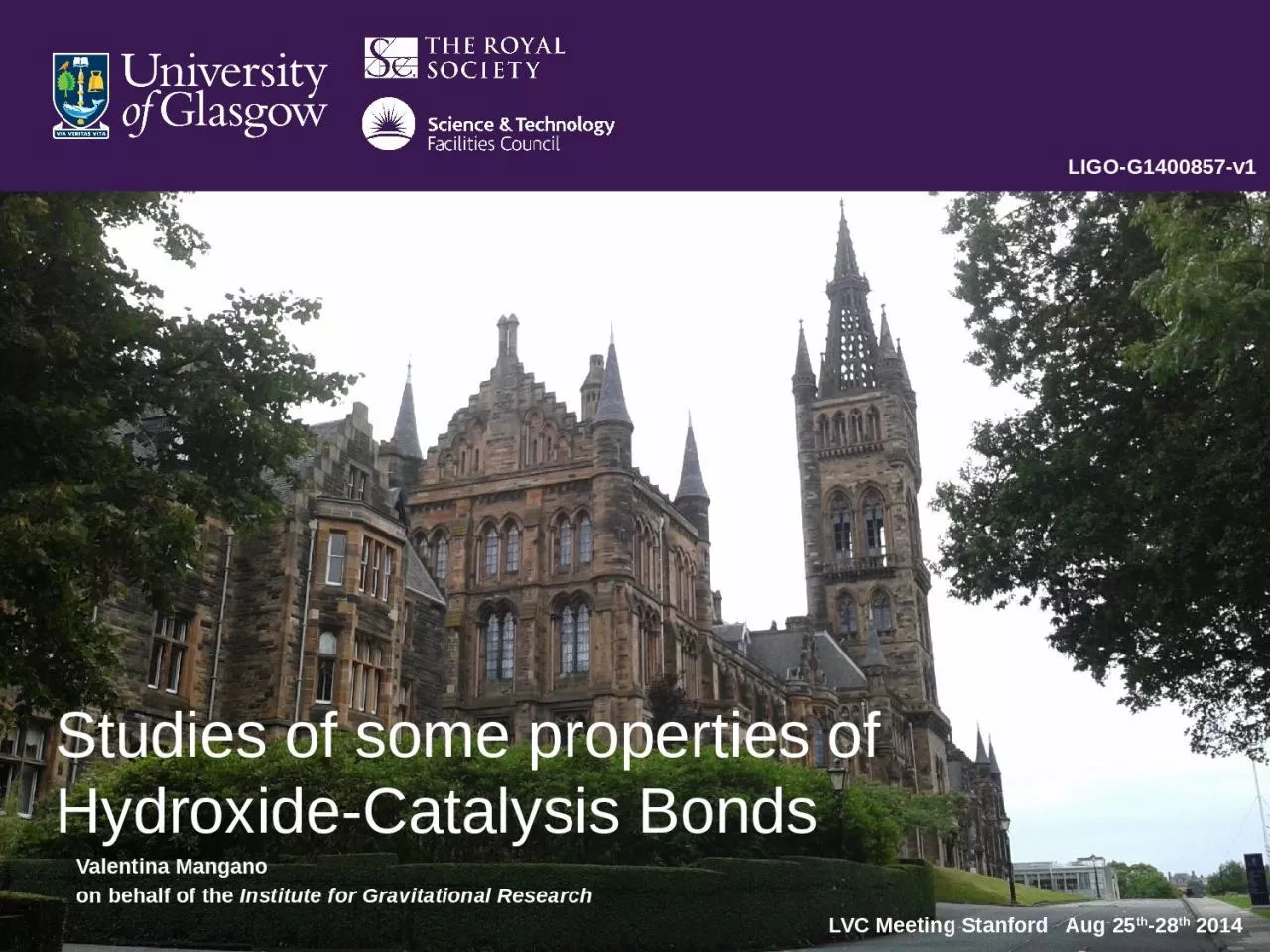

of HydroxideCatalysis Bonds Valentina Mangano on behalf of the Institute for Gravitational Research LVC Meeting Stanford Aug 25 ID: 1041928
Download Presentation The PPT/PDF document "Studies of some properties" is the property of its rightful owner. Permission is granted to download and print the materials on this web site for personal, non-commercial use only, and to display it on your personal computer provided you do not modify the materials and that you retain all copyright notices contained in the materials. By downloading content from our website, you accept the terms of this agreement.
1. Studies of some properties of Hydroxide-Catalysis BondsValentina Manganoon behalf of the Institute for Gravitational Research LVC Meeting Stanford Aug 25th-28th 2014LIGO-G1400857-v11
2. OutlineIntroductionFabrication of bondsOther applicationsExperimental setupResults and AnalysisConclusions and Future work2
3. Hydroxide-catalysis bonding is a jointing technique created at room temperature and characterized by:very thin bonds which only introduce low levels of mechanical losshigh strengthhigh precision alignmentHydroxide-catalysis bonding was used in GEO600, and it is being used in the quasi-monolithic fused silica mirror suspensions for the advanced gravitational wave detectors (aLIGO and advanced Virgo).To reduce the thermal noise further, cryogenic temperatures and crystalline materials, such as silicon and sapphire, are proposed for the next generations of detectors.Is it possible to realize such a mirror suspension at cryogenic temperatures with these materials using the hydroxide-catalysis bonding?IntroductionJuly 19983
4. It is possible to combine any material, provided that a silicate-like network can be formed between them.Example materials that can be bonded: oxide materials: silica, fused silica, Zerodur, ultra low expansion glass, granite and sapphire oxidisable materials: silicon and silicon carbideThe materials are bonded by means of an alkaline bonding solution: potassium hydroxide KOH sodium hydroxide NaOH sodium silicate Na2SiO3 Want to develop techniques to characterize bond properties for different substrates and solutions to allow us to tailor bond properties to the various utilizations of interest.Fabrication of bonds4
5. Jointing optical components with low losses and high strength can also be employed in various applications, outside gravitational wave field.(van Veggel, Killow - Adv. Opt. Techn. 2014; 3(3): 293–307) connection of a fiber injector with a collimated lens through a fused silica spacer (Taylor et al. - ASP Conference Series, 467 (2012)) adaptive mirrors of the telescopes to bond actuators to substrates (Strachan et al. - Proc. SPIE 7736, 773664 and 773661 (2010)) lightweight composite mirrors (MacKay et al. - Proc. SPIE 8884, Optifab 2013, 88841N (2013)) construction of high power lasers (Sinha et al. - Opt. Express 15, 13003 (2007)) transfer of a multilayer coating from a substrate to another one (Duchêne et al. – Opt. Commun. 285, 128‐132 (2011))Other applications5
6. Experimental setupAim: to measure the magnitude of the light reflected from bonded interfaces and use as a tool to determine bond thickness in a non-destructive manner.For this purpose:a pair of fused silica discs was bonded by means of sodium silicate solution;a setup to measure the reflectances of both polarisation components of the incident light of a green laser diode module (λ=532nm) on the sample was realised. 6
7. Experimental setupFor both the polarisations, the incident and reflected power of laser beam are measured as a function of angle of incidence, and the corresponding reflectances determined.7
8. bond surfaceback surfacefront surfaceResults8
9. Analysis: samplefused silicafused silicasodium hydroxide solution9
10. Analysis: formulaebond surfaceback surfacefront surface10
11. Analysis: front surface11
12. Analysis: bond and back surfaceThe thickness of bond can be made less than tens of nm for precision applications.(Gwo – US Patent 6284085B1 and 6548176B1).12
13. Analysis: bond and back surfacebond surfaceback surfacePreliminaryThe reflectivity of bond is < 7.00·10-4.(Sinha et al. - Opt. Exp. 15 (2007): < 7.08·10-4)13
14. There is a reasonable agreement between measurements and model up to 65 degrees angle of incidence.If the model is confirmed, it will be a powerful tool to: measure the bond thickness in a non-destructive manner;predict and measure how the reflectivity of a bond can be altered by the chemistry of a different bonding solution.In this silica sample:reflectivity of bond is < 0.1%;bond refractive index is (1.3±0.1);bond thickness is (14.0±1.9)nm.Conclusions14
15. → new sample (ø50.0×5.0)mmFor cross-check: refractive index of the bond → refractive index matching liquids sold by Cargille Laboratories thickness of the bond → using SEM or AFM microscopy techniquesHomogeneity across a bond and reproducibilityThree sapphire samples bonded with sodium aluminate, sodium hydroxide and sodium silicate solution → knowledge of how the reflectivity of the bond varies as a function of the chemistry of the bonding solutionFuture work15
16. Thank you for your attention!16
17. The process of hydroxide-catalysis bonding can be summarized in the following steps: hydration etching polymerisation dehydrationFabrication of bonds17
18. Analysis: formulae18
19. Refractive index of mixed solutions sodium silicate solution: Na2O ~ 10.6% + SiO2 ~ 26.5% + H2O ~ 62.9% bonding solution: 2 ml of sodium silicate solution + 12 ml of DI waterHow n2 can be estimated19
20. M. van Veggel (IGR group meeting - 2012)Measurements of d220